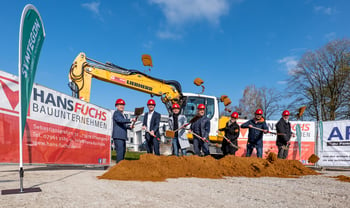How can a company supply one of its sites that has 70,000 square meters of net floor space, production, and office buildings with low-emission energy as self-sufficiently as possible? Besides the courage to break new ground, this goal requires committed employees and a clear vision.
The goal: zero emissions

How can a company supply one of its sites that has 70,000 square meters of net floor space, production, and office buildings with low-emission energy as self-sufficiently as possible? Besides the courage to break new ground, this goal requires committed employees and a clear vision. In the case of Syntegon’s Beringen site, the environment also plays an important role. By 2033, Syntegon wants to produce all its electricity and heat in Switzerland independently with the help of the sun and exceptional groundwater resources.

Heating and cooling with groundwater
Groundwater is generally regarded as a sustainable and reliable source of cooling and heating. The temperature of natural groundwater remains almost constantly at around 10 degrees Celsius. When pumped to the surface with a heat pump, thermal energy can be extracted from the water and be used, amongst others, to heat buildings. The technology can serve a different purpose at high temperatures by extracting cold from the water via a heat exchanger for so-called passive cooling. In both cases, the water flows back to the groundwater reservoir after usage and can be pumped back repeatedly. In Beringen, Syntegon has been leveraging this technology since 2011 for the entire office building and is currently using it for a quarter of the production halls.Volker Koch, head of environmental management at the Beringen site, explains how Syntegon uses groundwater to heat and cool its buildings.

Radiator panels and insulation
At the Swiss site, heat comes not only from below, but also from above. Syntegon is renovating the roofs of its production halls to this effect: radiant panels mounted on the ceiling ensure cosy temperatures in winter. The heat from the water-filled panels radiates evenly from top to bottom.
In summer, the plates are flushed with cooling water to cool the inside of the building. Syntegon is further gradually replacing the existing roof insulation with a new, 30-centimeter insulation made of mineral wool to ensure that the right amount of heat remains in the halls. The company is also renewing the roofing and glazing, using higher-quality materials with greater energy efficiency.

Electricity from sunlight
The renovated roofs of the production halls offer ample space for a large-scale photovoltaic system, which the Schaffhausen Cantonal Electricity Works (Elektrizitätswerk des Kantons Schaffhausen, EKS) has been operating at the site since the beginning of 2023.
With an output of around 1,128 kilowatt-peak (kWp), it is the most powerful plant of the Swiss EKS grid area and covers a quarter of the site's own electricity requirements. Up to 80 percent of the electricity generated via the system will serve the site’s own power needs – including lighting and heat pumps. Syntegon aims to have half of the site’s roof surfaces equipped with photovoltaic systems by 2027.
Energy generation on our own roofs
Photovoltaic system with over 3,000 modules and a combined area of over 5,000 square meters.
A tank full of energy
What to do with cost-efficiently generated electricity? This is a question that both individuals and companies are asking themselves – and they are looking for reliable storage options. Syntegon is on the same page: the company would like to temporarily store electricity from its photovoltaic system that exceeds current demand and be able to use it at a later stage.
Hydrogen storage offers a viable option, since hydrogen can be stored in gaseous, solid, or liquid form. This way, it serves as a carrier medium for electrical energy. Syntegon is keeping a very close eye on the market for potential technologies for intermediate energy storage.

The many steps to sustainability
With its multifaceted approach, Syntegon aims to gradually generate more electricity and heat from local natural sources in Beringen – in line with its sustainability targets. Syntegon already sources 100 percent green electricity.
A further important step is LED lighting. Since this year, Syntegon has been gradually converting the lighting in the factory halls to this energy-saving light source. From 2027 onwards, only 1,800 instead of 3,000 tons of CO₂ per year will be released into the atmosphere in Beringen compared to 2019. By 2033, the site also wants to meet its heating needs entirely with groundwater and no longer use fossil fuels.
The only hurdle is the site’s current lack of storage options, which are required to ensure self-sufficient energy supply. However, Syntegon remains confident that a corresponding solution can also be implemented in Beringen. In this case, the site would not only reach energy independency by 2033 but could also reduce emissions to zero.

Sun, water, and storage: energy from many sources
1. Current photovoltaic system
2. Roof renovation and expansion of the photovoltaic system until 2027
3. Roof renovation and expansion of the photovoltaic system after 2027
4. Utility room with heat pump
5. Groundwater infiltration

Sun, water, and storage: energy from many sources
6. Groundwater pumps
7. Main building and canteen already heated and cooled with groundwater since 2011
8. Radiant ceiling panels to heat and cool the factory building
9. LED lighting in office spaces Sun, water, and storage: energy from many sources
One overarching goal
Site Manager Bruno Oberle describes Syntegon's sustainability strategy in Beringen.
Towards a self-sufficient site
2011
Construction of the new office building including a heat pump for groundwater.
2023
Commissioning of the photovoltaic system of EKS.
2027
Half of the roofs of the production halls have new insulation, radiator panels, and photovoltaic panels.
2033
The electricity generated at the site can be stored. Syntegon has a self-sufficient energy supply.




